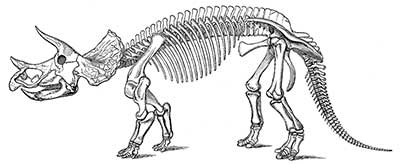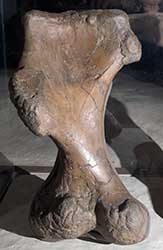Triceratops
(try-SAIR-uh-TOPS)
| Quick Facts | |
|---|---|
| Name Meaning: | Three-horned Face |
| Distribution: | Northwestern United States and Canada |
| Time Period: | Cretaceous, 70 Ma - 65 Ma |
| Length: | 30 ft. (9 m) |
| Height: | 10 ft (3 m) |
| Weight: | 6-12 tons |
| Diet: | Plant Life |
| Habitat: | Woodland |
| Linnaean Classification | |
| Kingdom: | Animalia |
| Phylum: | Chordata |
| Class: | Reptilia |
| Superorder: | Dinosauria |
| Order: | Ornithischia |
| Suborder: | Cerapoda |
| Infraorder: | Ceratopsia |
| Family: | Ceratopsidae |
| Genus: | Triceratops |
| Cladistic Classification | |
| |

History

|
| Triceratops horridus Right Humerus. |
Description
At 6-12 tons this dinosaur is enormous. The Triceratops is one of today's most popular dinosaurs. Its most distinguishing feature is its massive skull, which could reach up to one third of its total body length and featured a large frill and three horns, two long horns along the forehead and the third above the nasal cavities. The Triceratops walked on four legs and was similar to the modern day Rhinoceros. Two species of Triceratops have been identified: Triceratops horridus and Triceratops prorus with slight differences between the two. For example, the T. horridus had a smaller nose horn. However, some consider these differences to be the males and females instead of two separate species.Lifestyle
The Triceratops was certainly one of the most common herbivores of its time. Fossilized bone remains are many. This, however, does not necessarily mean that they lived in herds. Most Triceratops finds are generally of individuals, with the only "bonebed" found, to date, was a group of three juveniles. Triceratops were herbivores. They possessed a beak and a massive amount of teeth. They may have eaten large amounts of tough, fibrous material. The poster of the Triceratops has long been under debate. Some say that it walked slowly with its legs splayed out to the sides. Modern research, especially from footprint analysis, has determined that they may have walked with strait legs tucked under the body, but did not do so rapidly.Frill and Horns

|
| Two Triceratops horridus large brow horns, and one smaller nose horn. |
The use of the frill and horns is commonly under debate and many theories exist. The horns were probably used as a defense. This is supported by the fact that many horns and skulls show evidence of damage, later healed. The frill may have been used as a bonding place for jaw muscles, creating a stronger jaw. It may also have been used to increase the body's surface area for temperature control. Many believe it was used as a sexual display or a warning by flushing blood into veins along the frill. For this reason many artists portray the Triceratops with a pattern drawn on the frill.
ScienceViews Writer: Jason Hamilton.
Copyright © 2005-2010 Calvin & Rosanna Hamilton. All rights reserved.